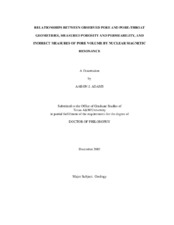| dc.contributor.advisor | Ahr, Wayne M. | |
| dc.creator | Adams, Aaron J. | |
| dc.date.accessioned | 2007-04-25T20:03:54Z | |
| dc.date.available | 2007-04-25T20:03:54Z | |
| dc.date.created | 2005-12 | |
| dc.date.issued | 2007-04-25 | |
| dc.identifier.uri | https://hdl.handle.net/1969.1/4710 | |
| dc.description.abstract | Carbonate reservoirs are a network of pores and connecting pore-throats that
contain at least half of the world's oil. Genetic classification of carbonate pores enables
one to map the pore types that have greatest influence on reservoir performance.
Though NMR logging has been used to estimate pore sizes, it has not been used to
identify genetic pore types or to aid in determinations of reservoir quality for different
pore assemblages.
Five genetic pore types identified in 40 carbonate and 7 sandstone samples were
subjected to NMR measurements. Results reveal close correspondence between NMRderived
pore volumes and 2-D pore size and shape gleaned from petrographic image
analysis. Comparisons of real and synthetic pore shapes showed that shapes of all pore
types in the medium size range of 0.02-0.5mm can be reliably compared with synthetic
varieties, but such comparisons were unreliable for vuggy pores smaller than 0.5mm. T2
relaxation times for depositional pores exhibit low amplitude, narrow wavelength
responses. Moldic pores produced medium amplitude, asymmetrical wavelength responses, and intercrystalline pores show high amplitude, narrow wavelength
responses. NMR-derived pore volumes on pores with ferroan dolomite interiors
underestimated pore diameter by up to 3 orders of magnitude. Calculated pore-throat
sizes from MICP data correlate strongly with measured permeability.
Samples with high, intermediate, or low poroperm values displayed characteristic
T2 curves confirming that reservoir quality can be estimated from NMR measurements.
Future work is expected to show that NMR logging can estimate reservoir quality at
field scale and aid in mapping flow units in compartmentalized reservoirs. | en |
| dc.format.extent | 14288154 bytes | en |
| dc.format.extent | 719360 bytes | en |
| dc.format.extent | 158208 bytes | en |
| dc.format.extent | 3842560 bytes | en |
| dc.format.extent | 22982656 bytes | en |
| dc.format.extent | 7159808 bytes | en |
| dc.format.medium | electronic | en |
| dc.format.mimetype | application/pdf | |
| dc.format.mimetype | application/vnd.ms-excel | |
| dc.format.mimetype | application/vnd.ms-excel | |
| dc.format.mimetype | application/vnd.ms-excel | |
| dc.format.mimetype | application/vnd.ms-excel | |
| dc.format.mimetype | application/vnd.ms-excel | |
| dc.language.iso | en_US | |
| dc.publisher | Texas A&M University | |
| dc.subject | Pores | en |
| dc.subject | pore throats | en |
| dc.subject | NMR | en |
| dc.subject | MICP | en |
| dc.subject | PIA | en |
| dc.subject | flow units | en |
| dc.title | Relationships between observed pore and pore-throat geometries, measured porosity and permeability, and indirect measures of pore volume by nuclear magnetic resonance | en |
| dc.type | Book | en |
| dc.type | Thesis | en |
| thesis.degree.department | Geology and Geophysics | en |
| thesis.degree.discipline | Geology | en |
| thesis.degree.grantor | Texas A&M University | en |
| thesis.degree.name | Doctor of Philosophy | en |
| thesis.degree.level | Doctoral | en |
| dc.contributor.committeeMember | Berg, Robert R. | |
| dc.contributor.committeeMember | Jensen, Jerry L. | |
| dc.contributor.committeeMember | Slowey, Niall C. | |
| dc.contributor.committeeMember | Willis, Brian J. | |
| dc.type.genre | Electronic Dissertation | en |
| dc.type.material | text | en |
| dc.format.digitalOrigin | born digital | en |


